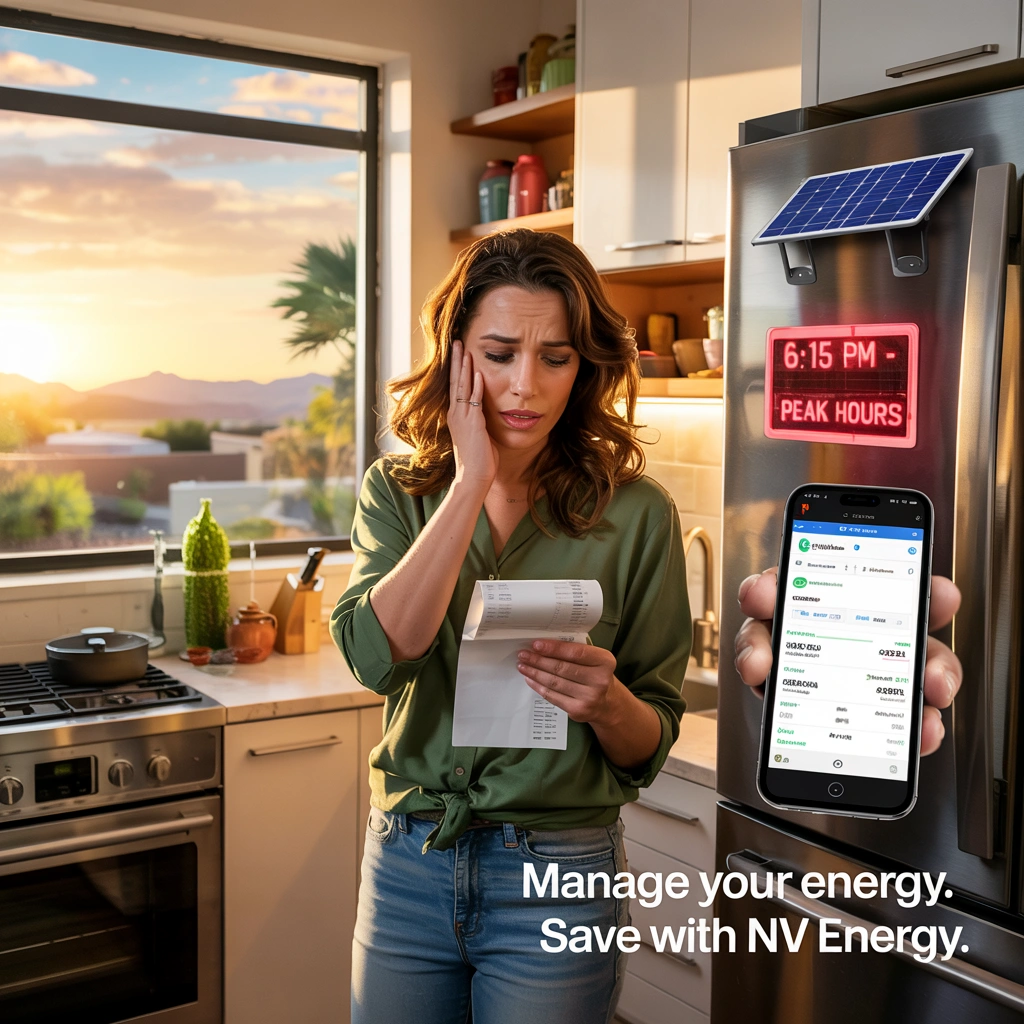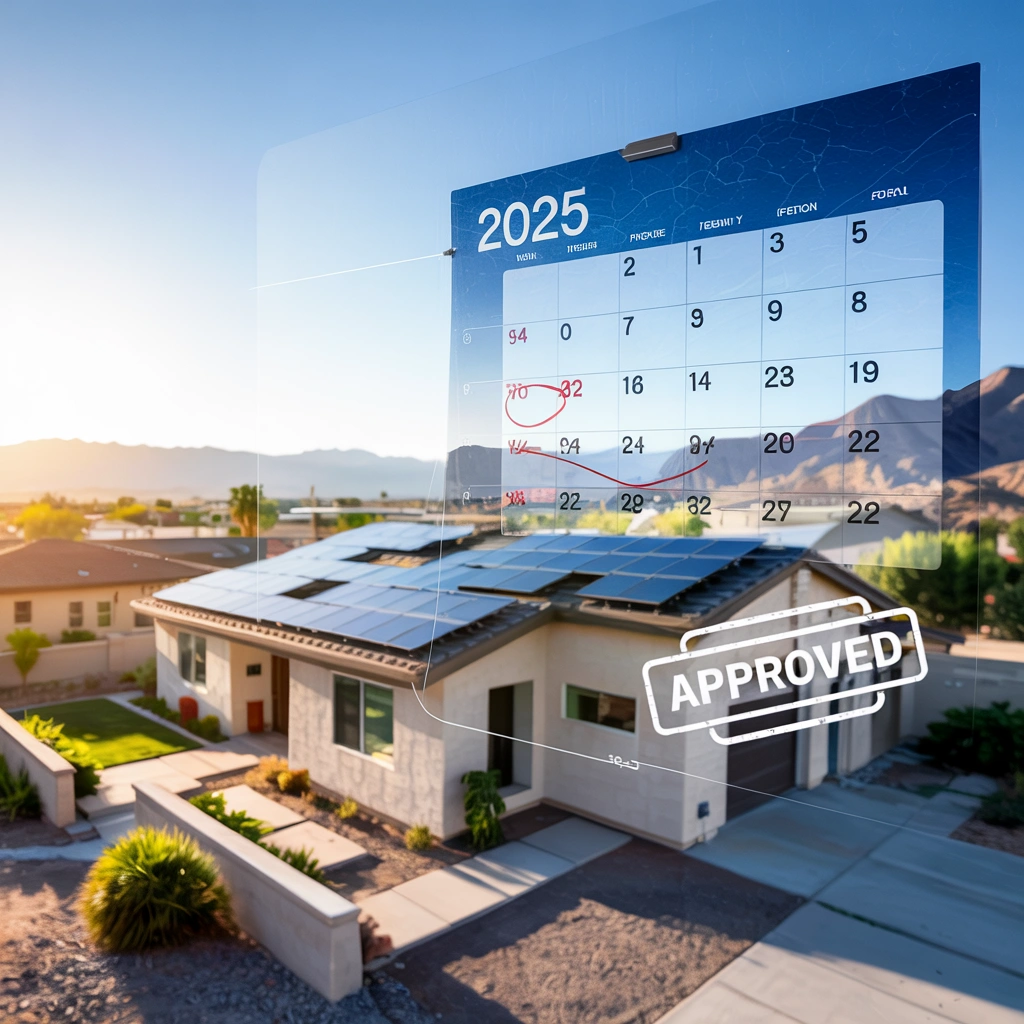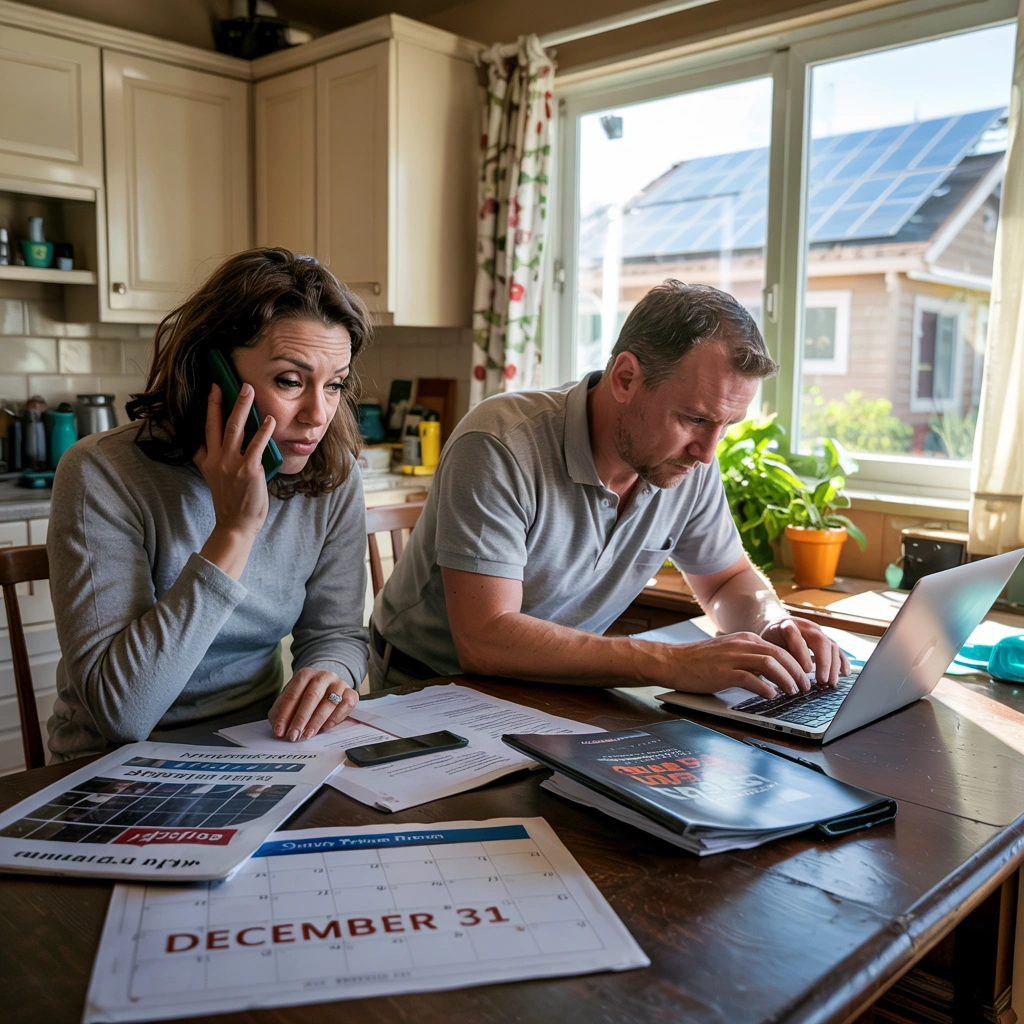
Summary: Are you prepared for NV Energy’s mandatory demand charges starting April 2026 that could add $20-$38 to every Southern Nevada electricity bill? Your current rate plan won’t protect you from this fundamental billing change.
PodCast: Discover whether NV Energy’s Time-of-Use plans will save or cost you money, plus what the mandatory demand charges starting in 2026 mean for Southern Nevada homeowners.
Key Takeaways
- NV Energy’s Time-of-Use plans can lower bills for flexible households but may increase costs for traditional 9-to-5 families who use most electricity during peak hours
- New mandatory demand charges start April 16, 2026, adding an estimated $20-$38 monthly to Southern Nevada bills regardless of your rate plan
- Electric vehicle owners and solar customers with battery storage typically see the biggest savings on Time-of-Use plans
- Demand charges are calculated differently than traditional billing – they’re based on your highest 15-minute usage spike each day, not total consumption
- Solar panels alone won’t protect against demand charges, but battery systems can help reduce peak usage spikes
Southern Nevada homeowners face a confusing maze of electricity billing options. NV Energy’s Time-of-Use plans promise savings for some families while potentially raising costs for others. Meanwhile, new demand charges are looming on the horizon, threatening to increase everyone’s bills regardless of the plan they choose.
NV Energy’s Time-of-Use Plans Won’t Always Increase Your Bill—But New Demand Charges Will
The answer to whether Time-of-Use billing increases electricity costs depends entirely on daily routines and energy consumption patterns. Some Southern Nevada families save $30-50 monthly by shifting their electricity usage to off-peak hours. Others see their bills climb by similar amounts when they can’t adjust their schedules.
Time-of-Use plans reward flexibility. Families who run dishwashers after 9 PM, charge electric vehicles overnight, and avoid afternoon air conditioning during summer peak hours (1 PM to 6 PM) often discover significant savings. The off-peak rate can drop to 5 cents per kilowatt-hour, while peak summer hours cost 18 cents or more.
Traditional 9-to-5 households face the opposite reality. Cooking dinner between 6 PM and 9 PM during winter peak hours, running laundry in the evening, and using electronics during prime time creates higher bills. These families benefit from understanding how emerging energy technologies and changing utility structures make solar investments increasingly vital for long-term bill protection.
Time-of-Use vs. Standard Rates: The Key Differences
Standard NV Energy billing maintains consistency. Customers pay approximately 11 cents per kilowatt-hour regardless of when electricity is used. A 1,200-kilowatt-hour monthly usage results in predictable costs around $150, including fees and service charges.
Time-of-Use billing creates price fluctuations throughout the day. The same 1,200 kilowatt-hour usage might cost $135 for families who time their consumption during cheap off-peak hours, or $175 for those who concentrate usage during expensive peak periods.
TOU Plans Offer Different Peak Hour Options
Southern Nevada residents face shorter peak windows than Northern Nevada customers. Las Vegas and Henderson see winter peak hours from 6 PM to 9 PM daily, while summer peak shifts to 1 PM to 6 PM on weekdays. This three-hour winter window provides more flexibility than Reno’s six-hour peak period, running 3 PM to 9 PM.
The shorter peak windows benefit families willing to adjust schedules. Starting dinner preparation at 5:30 PM instead of 7 PM avoids winter peak rates entirely. Running pool pumps from 10 PM to 6 AM captures the lowest electricity prices of the day.
Mandatory Demand Charges Start April 16, 2026
The Public Utilities Commission of Nevada approved a fundamental change to residential billing in September 2025. Starting April 16, 2026, Southern Nevada customers will face mandatory daily demand charges regardless of whether they choose standard or Time-of-Use billing.
These charges operate completely differently from traditional consumption billing. Smart meters monitor electricity usage in 15-minute intervals, identifying the highest demand period each day. That peak gets charged at approximately 18 cents per kilowatt.
New Demand Charges Add $20-$38 Monthly
NV Energy projects a $20 average increase, while consumer advocates warn that demand charges will increase most residential bills by $20 to $38 monthly. The actual impact depends on how much electricity households use during their peak 15-minute period each day.
Unlike traditional billing that rewards overall conservation, demand charges penalize concentrated usage regardless of total consumption. A family might use less electricity overall but pay more if they run multiple high-draw appliances simultaneously.
Daily Spikes Create Higher Bills: 8kW Usage = $1.44 Per Day
Consider a typical evening scenario. The oven preheats for dinner while the air conditioner kicks on due to the afternoon heat. Someone starts the dishwasher while another family member uses the clothes dryer. During those 15 minutes, the home draws 8 kilowatts of power.
At 18 cents per kilowatt, that single day generates a $1.44 demand charge. Multiply by 30 days, and the monthly demand charges reach $43. More realistic scenarios involve 4-6 kilowatt peaks during normal household activities, creating monthly charges of $22 to $32 added to existing bills.
Solar Customers Average $20, High-Usage Homes Face $38
Even homes with extensive solar panel installations face demand charges. Solar panels might cover 90% of monthly electricity consumption, but any 15-minute spike from the grid triggers the daily charge. Battery systems become necessary to smooth out these peaks and reduce demand costs.
High-usage households without solar face the steepest increases. Large homes with multiple air conditioning units, electric vehicle charging, pool equipment, and standard appliances frequently create 6-8 kilowatt demand spikes, pushing monthly charges toward the $38 upper estimate.
Who Saves Money on Time-of-Use Plans
Three groups consistently benefit from Time-of-Use billing structures. These households can shift significant electricity usage to low-cost periods while avoiding expensive peak hours through schedule flexibility or technology investments.
1. Electric Vehicle Owners
Electric vehicle charging represents 300-400 additional kilowatt-hours monthly for most drivers. Charging during peak hours costs $54-72 monthly at summer rates. The same charging during off-peak hours costs $15-20. Annual savings reach $450-625 for families who charge overnight.
NV Energy offers special EV Time-of-Use rates that further reduce overnight charging costs. Combined with Time-of-Use billing, electric vehicle owners often see their total electricity bills drop despite adding significant consumption.
2. Solar Panel Owners with Battery Storage
Solar panels generate electricity during expensive peak hours when rates reach 18 cents per kilowatt-hour. This timing creates immediate value by avoiding the highest-cost electricity. Battery systems store cheap off-peak power for use during expensive periods, maximizing savings.
The combination protects against both Time-of-Use rate variations and upcoming demand charges. Batteries can discharge during 15-minute usage spikes, preventing high demand charges while solar panels offset peak-hour consumption.
3. Flexible Schedule Homeowners
Retirees, remote workers, and shift workers can time major appliance use around peak hours. Running washing machines before 1 PM, using dishwashers after 9 PM, and precooling homes before peak hours can reduce bills significantly.
One Henderson couple reported saving $35 monthly simply by adjusting when they used appliances. Their total electricity consumption remained the same, but timing changes shifted usage from 18-cent peak hours to 5-cent off-peak periods.
Who Pays More Under New Rate Structures
Traditional household schedules often conflict with Time-of-Use savings opportunities. Families with inflexible routines find their electricity costs climbing under both current TOU plans and future demand charges.
Traditional 9-to-5 Households
Working families typically arrive home between 5 PM and 6 PM, right when winter peak hours begin. Dinner preparation, homework time with computers and lights, and evening laundry all occur during the most expensive electricity periods.
These families use 60-70% of their electricity during peak hours, creating bills that increase $25-40 monthly compared to standard rates. The inability to shift major usage to off-peak periods eliminates potential savings.
High Evening Usage Families
Households with teenagers gaming online, multiple televisions running, and heavy evening appliance use face the steepest increases. Peak-hour consumption often exceeds 70% of total usage, making Time-of-Use plans expensive.
These families benefit from energy management systems that automatically delay non-essential appliance operation until off-peak hours. Smart water heaters, programmable dishwashers, and automated pool equipment can shift some usage without lifestyle changes.
Solar and Storage Provide Limited Protection
Solar panel installations help with Time-of-Use billing by generating electricity during expensive peak hours. However, the upcoming demand charge system creates new challenges that solar panels alone cannot address.
Battery Systems Can Reduce Some Demand Spikes
Battery storage systems smooth out electricity usage by discharging during high-demand periods. Instead of drawing 8 kilowatts from the grid during a usage spike, a home might draw 2 kilowatts from the grid and 6 kilowatts from batteries. This reduces the daily demand charge from $1.44 to $0.36.
Properly sized battery systems can eliminate most demand charges for typical residential usage patterns. However, extremely high-usage periods—such as charging electric vehicles while running multiple appliances—may still create demand charges even with battery backup.
Net Metering Cannot Offset New Demand Charges
Nevada’s net metering program credits solar customers for excess electricity sent back to the grid. These credits offset consumption charges but provide no protection against demand charges. A home that produces more electricity than it consumes still faces demand charges for any power drawn from the grid during peak usage moments.
This reality makes battery storage increasingly valuable for solar customers. Batteries prevent grid draws during usage spikes while allowing solar panels to continue offsetting total consumption through net metering credits.
Switch to Time-of-Use Now or Install Solar Before April 16, 2026
NV Energy offers a risk-free trial period for Time-of-Use plans through its Guaranteed Lowest Rate feature. The utility analyzes usage after twelve months and refunds any difference if the standard rates would have cost less. This removes financial risk from trying TOU billing.
Homeowners considering solar installation should act before demand charges take effect. Current net metering rules provide better long-term returns than future policies might offer. Federal tax credits remain at 30% through December 31, 2025, while battery incentives help offset storage system costs.
The combination of solar panels and battery storage provides the best protection against both Time-of-Use rate increases and upcoming demand charges. These systems generate electricity during expensive peak hours while preventing usage spikes that trigger demand charges.
Rate structures will continue changing as Nevada’s electricity grid modernizes. Homeowners who invest in energy independence through solar and storage gain control over their electricity costs regardless of future utility rate modifications. The window for maximizing these benefits under current incentive programs closes rapidly as 2026 approaches.
For expert guidance on navigating Nevada’s changing energy landscape and solar investment strategies, visit M&J Trusted Marketing, where experienced professionals help homeowners make informed decisions about energy independence and long-term cost protection.
Frequently Asked Questions
How Solar Installation Companies Can Leverage This Content
This informative article, “Will NV Energy’s Time-of-Use Plan Increase My Electricity Bill?” can be adapted and repurposed across multiple marketing formats to help increase website traffic for kitchen remodeling services, build trust with potential clients, and differentiate their services in a competitive market. We help with “Turn Solar Education Into Sales: Content That Converts Curious Homeowners” by transforming technical content into powerful marketing campaigns across all digital channels, ensuring maximum reach and engagement with potential customers.






